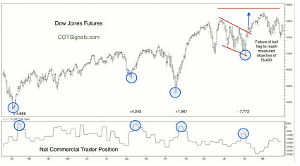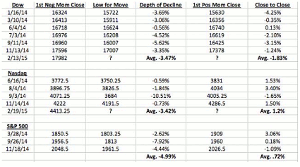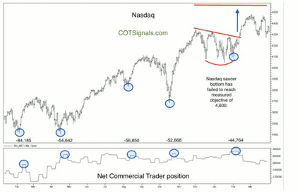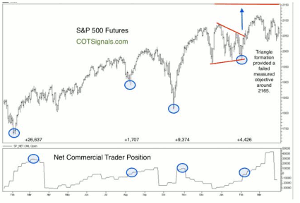The weekly Commitment of Traders (COT) reports have always made up one of Andy Waldock’s, of Commodity & Derivative Advisors, primary data streams; here, he combines the net commercial trader position based on the weekly COT report with the daily charts of the indices themselves.
I understand that our weekly readers may feel like we're beating a dead horse over the last few weeks. We've stated and re-stated various reasons for our concerns regarding the equity markets and this week has provided yet more fuel for the warning signal. First of all, let me begin with my personal bias by stating that, as an S&P 500 pit trader whose only decade on the floor was the 1990s, I'm used to making money on the long side. However, there are enough warning signs in the marketplace right now that I won't take a long position home. I believe the next home run trade in these markets will be on the short side, and this week, I'll provide one more big money example.
Since moving off the floor, my trading has necessarily evolved to be primarily quantitative in nature, if not outright mechanical via direct algorithm deployment. To this end, the weekly Commitment of Traders (COT) reports have always made up one of my primary data streams. This report breaks down the trading action of the market's four main types of participants; index traders, small speculators, large speculators, and commercial traders. Long story short, we focus on the commercial traders as the market participants best able to ascertain a given market's value. After all, they're the ones pulling it out of the ground or processing it for our shelves. Of course, an argument can be made that the stock market is not a commodity and is therefore not subject to the same physical laws and I'd agree.
In the following charts, we'll combine the net commercial trader position based on the weekly COT report with the daily charts of the indices themselves. There are two points to be made. First of all, the bullish technical formations did push us to new highs, but none of them reached their measured technical objectives. Second, the commercial traders are becoming less and less convinced about the buy side of the equity markets at these prices.
The Dow futures are probably providing the most technically perfect chart to examine, so we'll begin there. Notice the technical formation in the upper right hand corner of the chart. This year has been characterized by a developing bull flag formation. The market traded broadly lower with consistent volatility at both the highs and lows. February's penetration of the upper boundary of the flag did bring new, speculative and index buying with it and pushed the market to an all time high of 18,270, nearly reaching the measured objective of 18,400.
Commercial traders have become less willing to buy the Dow Jones Industrial Average (DJIA) at these prices.
NEXT PAGE: Another Chicken and Egg Case
|pagebreak|Moving to the commercial trader portion of the Dow futures picture clearly shows that commercial traders have become far less interested in owning the Dow Jones Industrial Average at these prices. Their buying has decreased on each market decline of significance for more than a year. Thousands of articles have been written over the last year regarding how long in the tooth this equity rally has become. There is little doubt by nearly any historical measure that the stock market rally from the 2009 lows has been unprecedented. This is not to say that commercial traders are perma-bears. Far from it. However, when they turn bearish, their effect on the market is quantifiable as we published in this chart from, Equity Rally Waves a Caution Flag.
Quantitative effect of negative commercial traders bias on the stock index futures.
The Nasdaq 100 futures chart is less impressive but still validates the two points made in the Dow Jones. The Nasdaq failed to reach its technically measured bullish objective and the commercial traders have been steady sellers on the market's advance to the recent highs.
Another chicken and egg case. Did the Nasdaq fail to reach its objective because of commercial selling or were commercial traders selling because they knew it wouldn't make it?
Two quick points on this chart. The technical formation is a saucer bottom rather than the bull flag of the Dow. Roughly measured, it failed to reach its objective. Secondly, the commercial trader position appears relatively flat in the scale above and this can be a problem with weekly COT data in general. We've found that tracking the momentum of their buying and selling provides significant clues into their desperation to act at a given price level.
Finally, moving to the S&P 500 we see that the patterns are longer and more protracted than the more narrowly based Dow Jones and Nasdaq at 30 and 100 stocks, respectively. Three points to the final and most alarming chart. Technically, the S&P 500 futures failed to reach the measured objective from the breakout of their triangle formation. Secondly, the commercial traders in the S&P 500 had built up the most bullish position among the indices on a relative basis, which leads to the third point. Commercial traders are bailing out of their massive position at an extreme pace, having set a new record by selling more than 57,000 contracts in the last week.
Commercial traders lead the chant, "We're long and we're wrong."
By Andy Waldock, Founder, Commodity & Derivative Advisors

























